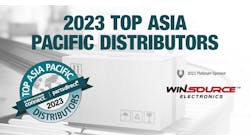Last year was an investment year for many electronics distributors, and Montreal-based Future Electronics is no exception. The company added salespeople and engineers worldwide in 2012 to satisfy growing demand for technical assistance and supply chain planning programs and is now poised for growth in the second half of 2013. Executive vice president Lindsley Ruth sat down with Globalpurchasing.com at the May 2013 Electronics Distribution Show in Las Vegas to talk about some of the company’s newest offerings and its outlook for the electronics market for the rest of the year. What follows are excerpts from our conversation:
Globalpurchasing.com: With the first quarter of 2013 behind us and the second in full swing, what is your outlook for the electronics distribution market for the remainder of the year?
Globalpurchasing.com: In an interview for Globalpurchasing’s Top 50 Electronics Distributors, you referred to 2012 as an investment year for Future. What key investments did you make and how are you reaping the rewards of those investments in 2013?
Ruth: Our competitors view their two greatest expenses as inventory and people. We view inventory and people as an investment. So those are two areas we invested in in 2012, and we continue to do so in 2013. From an investment perspective on the people side, we’ve increased the number of engineers worldwide; we’ve also increased the number of salespeople. We have also made major investments in training in the last two years. We want to make sure our people are well trained on how to position the company we have today. And it’s a very different company today than it was 10 years ago. We have completely different capabilities. We don’t have any challenges from a warehousing perspective. From a credit perspective, there are no issues on capital or funding. We can give any customer that’s credit worthy 180-day terms. We’ll hold four months’ worth of inventory.
Related Articles
We’ve made investments to provide the best service level in the industry; we work with our customers not against them. Our major focus is helping them with their customers.
Globalpurchasing.com: Future Electronics recently announced the re-launch of FAI, a division that ran for about 15 years targeting new or underserved customers with a team of newly trained salespeople. Can you talk about the reasons behind the re-launch?
Ruth: Twenty years ago—April 15, 1993—we launched FAI in the Americas because [company founder] Robert Miller saw a need to have another division to focus on the market we weren’t currently servicing. He wanted to go aggressively attack those customers with people who had a limited amount of experience, an open mind and were aggressive in pursuing the market.
Within five years of launching the program in 1993 it exceeded $500 million. So it’s a model that worked out very well. Many of our top customers today came from the FAI model—and many of our sales leaders did, too. We see the same need we saw 20 years ago. We see a market that’s not being serviced properly. Our goal this time is to exceed $1 billion dollars in five years.
We’ll have 100 FAI salespeople on the street by the end of the year, backed up by over 100 people on the inside. We have had a very active recruiting effort for the program. For every 10 resumes we’ve seen we’ve hired one person. We’re looking for people with two to five years of sales experience, but not necessarily in electronics. Then we put them through a Future boot camp for one month.
Globalpurchasing.com: Many industry-watchers continue to point to the Internet as a game-changer for the industry, particularly when it comes to e-commerce and social media. What’s your take on this? How are these technologies changing the way you interact with customers and suppliers?
Ruth: I think it’s still too soon to tell what the [Internet’s] impact is going to be on the industry. This is one area where we’ll see a need emerge in Asia prior to the Americas because the average age of engineers and buyers in Asia is younger and you see a much higher use of social media there.
Certainly if you look at e-sales, the percentage of business that’s transacted in some type of automated fashion is going to increase exponentially over the next few years and that takes away a lot of the face-to-face interaction. That really changes things.
Globalpurchasing.com: It sounds like you may think that’s a negative consequence.
Ruth: Well, we can’t lose focus on what business is all about. There are still phones on everyone’s desk for a reason. That’s still an important part of the business. We don’t want to lose the verbal or face-to-face communication. Business all still boils down to relationships, and it’s very difficult, from my perspective, to develop relationships over social media.
Globalpurchasing.com: Another key trend shaping the industry is globalization. How is this affecting the industry in general?
Ruth: It’s introducing an increased level of complexity and adding cost to the industry. We now have a model where you have to execute more globally. There are a lot of customers today who will design a product in multiple regions, for instance, and that level of complexity is not easy for regional distributors to serve. But it’s a huge advantage for Future. We can execute the same program seamlessly in any region. The greater the level of complexity, the better it is for us.
Globalpurchasing.com: To follow up on that, how is globalization affecting a company like Future?
Ruth: We love complexity. And I think we’re very well positioned globally, in Asia in particular. Asian distributors have the least amount of inventory of any distributors worldwide—their margins are so low they can’t afford to take risk and invest in inventory. So they have a very, very challenging model. But we can offer the same service level anywhere. There’s no distributor that has a perfect pipeline model, but the only way you can offer near-perfect on-time delivery is to hold the inventory.
Globalpurchasing.com: What other industry trends are you watching today, particularly as they relate to customers and the supply chain?
Ruth: Definitely, number one, we’re always watching trends involving lead times and security of supply. Unfortunately, natural catastrophes that you can’t predict or forecast seem to be getting more common. We plan for that. Our number one value proposition is as a supply chain insurance policy, but at no cost to the customer. Second, I would say the increased level of design services that our customers [demand] and the willingness of our suppliers to compensate their distribution partners for the services they provide. You also have to make sure you’re selecting the right customers. Depending on the markets you’re serving, design cycles can be anywhere from 12 months to three years, so it’s a major investment from a parts perspective and the engineer’s time [to serve those needs]. So that’s a challenge.
Emerging markets [is another issue]. We haven’t talked at all about lighting. That’s the fastest growing part of our business worldwide. We have Future Lighting Solutions that will exceed a billion dollars in revenue in the next two years. The technology continues to improve, availability is improving, and customers are moving more rapidly to adopting high-powered LED technology, as well as mid-powered [solutions]. We’re seeing growth rates of 25% to 30% per year for the next five to six years. There is rapid adoption, not only because the lights last longer, but because they are substantially more energy efficient.
Other emerging markets include anything related to energy. With solar there are a lot of question marks, but there are still some great opportunities for us in that area. Power management is a major issue, and we see a major opportunity in connectivity—RF and wireless in particular, as more and more products shift to that technology.
Lindsley Ruth is executive vice president, office of the president, for Future Electronics. The global distribution company ranked third on Globalpurchasing.com’s 2013 Top 50 Distributorslist, with sales of approximately $7.4 billion.









